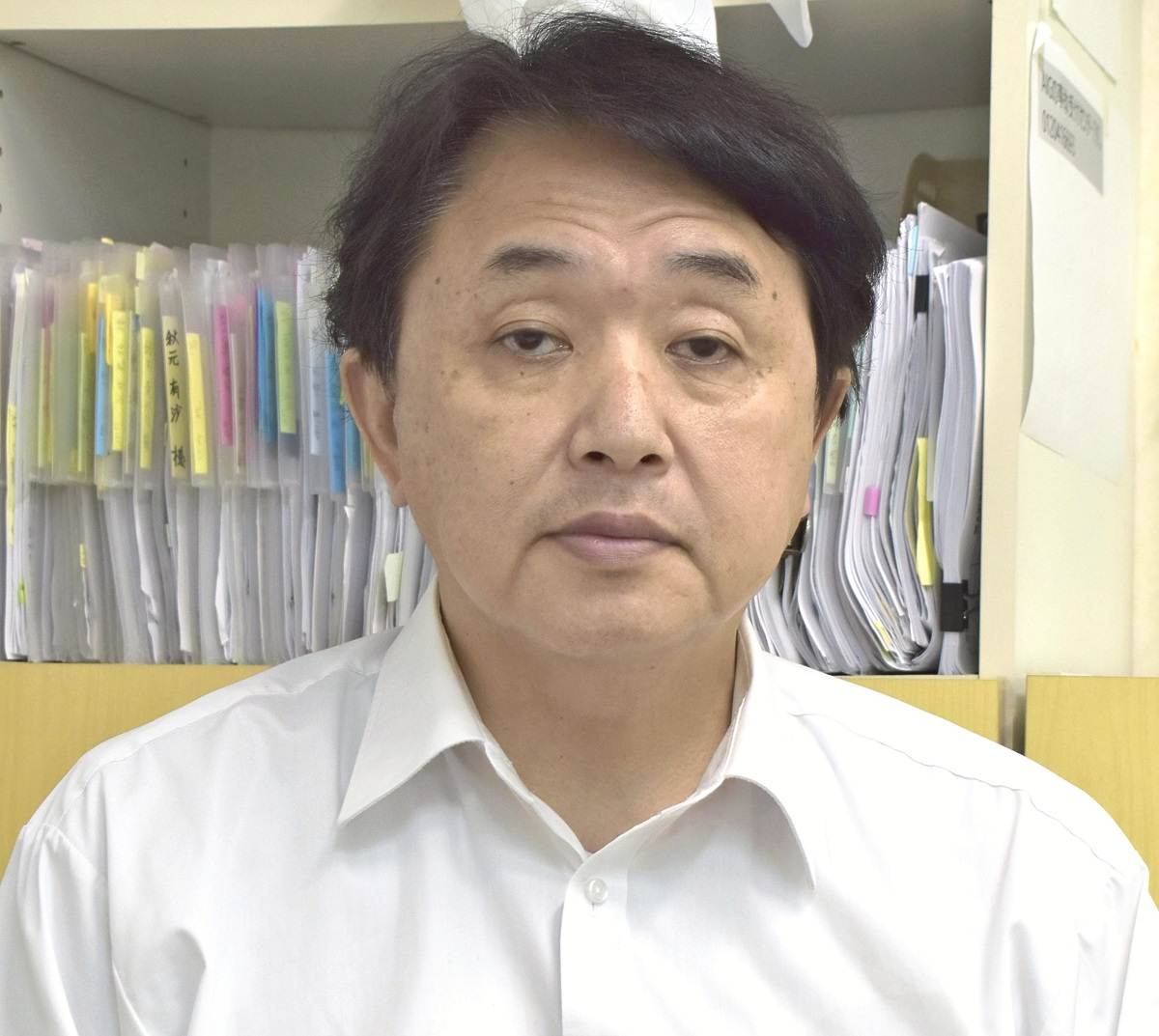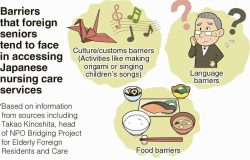
Hideji Tanaka sits in front of a personal computer in an apartment unit where he lives alone in Adachi Ward, Tokyo.
13:21 JST, October 2, 2023
Many people with physical disabilities want to live independently. This article examines how some of them lead their everyday lives and what kind of hurdles they faced in their journey to live by themselves.
□□□
Hideji Tanaka, 55, began living alone in an apartment unit in Adachi Ward, Tokyo, from February. He has physical and speech disabilities due to cerebral palsy, and uses an electric-powered wheelchair when he goes out.
During the day, he is accompanied by a helper. At night, he spends time by himself.
When I visited, he greeted me in pink clothes, which he likes to wear. His curtains, chairs and bed sheets are all pink.
“I couldn’t do this when I lived with my mother. Living alone is nice and free,” he told me through a communication board.
Tanaka lived with his family, and worked in IT until his paralysis worsened, resulting in him giving up his job when he was 34.
His father had passed away, and his now 81-year-old mother took care of him with the assistance of a helper. Thinking that he couldn’t rely on his mother’s help forever, he began searching for a way to become self-reliant.
Securing housing was extremely difficult. Even though he could afford to pay rent, he was repeatedly turned away by real estate agents who told him that no landlords would be willing to rent out rooms to people with disabilities.
After searching for information, he came across Make Home Co., which helps disabled and elderly people find places to live. The company, designated as an aid organization by the Tokyo metropolitan government, searched for properties and negotiated with real estate agents while explaining Tanaka’s needs.
After being turned down for more than 10 properties, Tanaka finally decided to move into a property that is fully managed by Make Home, which takes care of problems and installs necessary equipment such as handrails. The building’s owner is not involved with choosing the tenants.
After struggling for a long time, Tanaka can now have fun drinking at night and communicating online with his friends, enjoying an independent lifestyle. Being alone at night is a concern — he once suffered a fall on a trip to the bathroom, causing a slight wound. Even after the incident, he said, “I didn’t think that I would stop living alone.” He said that his mother feels a little lonely but feels glad that he can live by himself.

Make Home Co. President Koichi Ishihara
Make Home President Koichi Ishihara, 57, said, “Though there are [disabled] people who can live alone after taking various measures, there are, regrettably, many landlords who do not accept people’s requests because of concerns over communication or starting fires.”
Using an induction cooktop is one way to increase safety. For the hearing-impaired, flashing warning lights can supplement fire alarms, and e-mail can enable easier communication. Uneven floor spaces can be overcome by installing simple slopes.
Ishihara himself has a leg disability resulting from an injury, and he is blind in his left eye due to an illness. He holds seminars for local governments and the real estate industry, urging them to deepen their understanding of disabled people’s needs, and to “understand that anyone can become disabled.”

Tanaka points to letters on a communication board when he communicates with others.
Legal assistance
The Health, Labor and Welfare Ministry in 2021 conducted a survey on 4,000 disabled people living in group homes. Of those who responded, 36% said that they wanted to live independently.
Last year, the Law on Providing Comprehensive Support for the Daily Life and Life in Society of Persons with Disabilities was revised. Residents living in group homes who wish to live alone are now entitled to support, as well as counseling after leaving a facility.
Though details of the new assistance will be decided by the end of this fiscal year, an official of the ministry said: “Gaining understanding from the real estate industry is essential. It will be also imperative to collaborate with organizations supporting disabled people who live in rented housing as tenants.”
Calligrapher enjoys network of neighborhood ties
Calligrapher Shoko Kanazawa began living alone in a one-room apartment in Ota Ward, Tokyo, in December 2015.
Kanazawa, 38, has intellectual and speech disabilities due to Down’s syndrome and finding somewhere to live independently was a challenging task.
Recalling that time, Kanazawa’s 79-year-old mother, Yasuko, said: “I was very anxious. It would have been difficult for Shoko to live alone without [help from] people living in the area.”
Kanazawa’s apartment sits within a shopping district, and, with a passion for interacting with others, she has expanded her personal connections in and around her home patch.
Local residents are happy to help Kanazawa. For example, she has difficulties dealing with money. So, when she pulled out a bag full of coins at a coffee shop and asked shop owner Hiroko Ueno, 75, for help, Ueno cheerfully extended a helping hand.
Kanazawa learned how to sort garbage and clean up from a woman working at a pork cutlet restaurant. She has also made it a habit to chat with the owner of a Japanese confectionery store and sing songs with her.
Kanazawa refers to people in the shopping district who have helped her as “second mothers and fathers.” Due to the large amount of time she has spent in the area, her “family members” have increased.
For safety reasons, Kanazawa uses an induction cooker at home and does not employ oil very often. At one point, she was eating too many snacks and had to be careful about her health. To counter her overindulgence, she wrote “I’ll lose weight!” on a piece of paper and stuck it to a wall in her home, which inspired her to exercise diligently.
Every few days, she receives living expenses from her mom.
Kanazawa often practices Michael Jackson-like dance moves in her room, and likes to transcribe Buddhist sutras.
“My specialty dish is tandoori chicken,” she enthused. “And recently, I like listening to classical music.”
When asked what she likes most about living alone, she quickly replied, “The freedom!”
Last year, Kanazawa’s mom bought a building comprising an art gallery and a residence. Kanazawa moved into the building, but her residential space is on a different floor and has its own entrance, so Kanazawa is still technically living on her own. The building is near the shopping district, allowing her to continue interacting with local residents.
“Shoko has found her own place to live in the town,” Yasuko said. “Anyone can end up alone. Finding people who can help you is the key to living alone.”
"JN Specialities" POPULAR ARTICLE
-

The Japan News / Weekly Edition (12/12-12/18)
-

Noodle Dining Shunsai / Rich Oyster Ramen to Savor at Odasaga; Experienced 68-year-old Owner Creates Numerous Ramen Varieties
-

The Japan News / Weekly Edition (12/5-12/11)
-

People Keep Loved Ones’ Ashes Close in Special Jewelry, Small Urns as Unique Way to Memorialize Them
-

The Japan News / Weekly Edition (12/19-12/25)
JN ACCESS RANKING
-

Tokyo Economic Security Forum to Hold Inaugural Meeting Amid Tense Global Environment
-

Keidanren Chairman Yoshinobu Tsutsui Visits Kashiwazaki-Kariwa Nuclear Power Plant; Inspects New Emergency Safety System
-

Imports of Rare Earths from China Facing Delays, May Be Caused by Deterioration of Japan-China Relations
-

University of Tokyo Professor Discusses Japanese Economic Security in Interview Ahead of Forum
-

Japan Pulls out of Vietnam Nuclear Project, Complicating Hanoi’s Power Plans
























